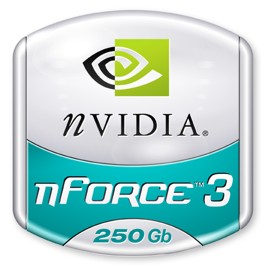First Chipsets for Socket 939 Athlon64
To support the new Socket 939 processors, we have
competing chipsets from VIA and nVidia, the K8T800 Pro and Nforce 3 Ultra
respectively.
Both of these chipsets represent the current state
of the art for AMD processors. While Intel's newest offerings may have slightly
more features, including support for DDR2 and PCI-Express, neither of these
chipsets will leave enthusiasts wanting.
Let's take a closer look at the features that each
chipset offers, beginning with Nvidia's Nforce 3 Ultra
Nforce 3
Ultra specs and features
As mentioned above, the Nforce 3 Ultra chipset for
socket 939 is a retooled version of Nvidia's previous offering for the Socket 754 AMD processors,
the Nforce 3 250GB. In order to manage this upgrade, Nvidia had to design a new
MCP (Media Control Processor), its' terminology for the chip that handles
graphics information and I/O on the new chipset.

The Nforce 3 Ultra is a single-chip solution,
meaning that instead of separating the chipset functions into the traditional
Northbridge and Southbridge chips, both functions are combined into a single
chip, the MCP we referred to above. This design is a logical reaction to the
changes introduced by AMD's 64 bit processors, which build the memory controller
into the processor. Traditionally, this controller was part of the Northbridge
chip's duties, but now it makes much more sense to consolidate all functions of
the chipset into a single IC and cut out on the potential data bottlenecks that
can occur when the Northbridge and Southbridge communicate.
The most significant change made to the MCP is
the Hypertransport link between the processor and the chipset. It now supports
up to 8GB/s of bandwidth, to provide the headroom needed to drive the new
generation of Athlon 64 processors.
Other features of the chipset include built-in
Gigabit Ethernet support, built directly into the MCP chip. This is a first as
far as we are aware. Other manufacturers have added Gigabit chips to their
boards in connection with the existing chipset, but none have been wholly
integrated into the chipset. By doing things this way, Nvidia hopes to avoid the
bottleneck that gigabit Ethernet devices attached to the low bandwidth PCI bus
can cause. Business customers should take note of this.
In another first, Nvidia has decided to partner
this built in networking ability with a hardware firewall integrated into the
chipset. The firewall is a 'personal' one, apparently similar in operation to
the Windows XP firewall. It should provide the important ability to block
outgoing data as well as incoming data, to provide protection against spyware
and Trojan horse viruses. As it is built into the chipset, it is 'always on,'
being started while the PC is booting up, provided the user has not disabled it.
It should also be a fair bit easier on system resources than its purely software
competitors like the WinXP firewall and Zonealarm.
Two serial ATA controllers are included, providing
support for up to four serial-ATA hard drives. Unlike Intel's newest offerings
for the P4, Nvidia is still firmly supporting ATA-133, and the Nforce 3 Ultra
can host up to six such devices. Eight USB 2.0 connections are present. RAID
support is built into the chipset. RAID 0, 1 and 0+1 are available, providing a
good balance between security and performance, provided you have enough drives
to go around. Both Serial-ATA and ATA-133 drives will be supported by RAID. A
graphical interface will guide users though setting up their RAID configuration.
The Nforce 3 Ultra chipset will support the AGP8X
standard for video cards, with PCI-Express relegated to future chipset releases,
like that of the nForce 4.
Audio should be provided by the now familiar 6.1
channel AC 97 2.1 standard, though Nvidia's documents indicate that a 7.1
surround option will also be available for manufacturers.

